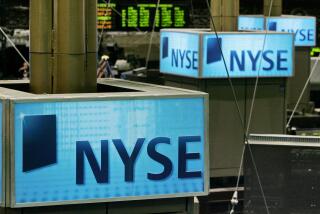Dow Unable to Stay at Record Pace, Falls 17.11 : Market Overview
- Share via
Highlights of Tuesday’s market activity, compiled from Times staff and wire reports:
* Stock prices fell Tuesday, with health care issues taking a hit and the Dow Jones industrial average retreating from Monday’s record close. On Monday, the Dow had risen 16.33 to 3,413.21, topping the previous closing peak of 3,398.43 from Thursday. The Dow finished Tuesday down 17.11 points at 3,396.10.
* Bond prices retreated in early trading on good economic news, then rebounded and ended higher after the Federal Reserve unexpectedly swooped in to buy Treasury securities.
Stocks
The market hovered near its record high much of the day, though it was held back by losses among health care stocks. Then, when a rally in bond prices failed to spill over into the stocks, some investors became nervous and staged a late selloff.
* Leading the NYSE most-active list was Bristol-Myers Squibb, down 6 7/8 at 66 7/8 with more than 10 million shares trading hands as the company reported disappointing growth in sales. That dragged other drug and health care stocks lower.
* Abbott Laboratories was down 1 at 32 3/4, Glaxo Holdings was down 1 1/4 at 27 1/4, Humana was down 3/8 at 20 1/8, Eli Lilly was down 2 1/4 at 64 3/4, Merck was down 1 1/2 at 49 5/8, Syntex was down 2 5/8 at 35 3/8, and Upjohn was down 7/8 at 34 3/4. Johnson & Johnson was down 5 5/8 at 92 3/8, and Pfizer was down 3 1/4 at 71 1/2.
“The drugs need a prescription,” said Larry Wachtel, who follows stocks for Prudential Securities Inc. “That’s where the weakness is coming from. The overall market is just on track.”
In the broader market, declining issues outnumbered advancing ones by about 9 to 8 Tuesday on the New York Stock Exchange.
Big Board volume totaled 203.08 million shares, compared to Monday’s 190.64 million.
Traders were taking a mix of economic news in stride, he said.
The Commerce Department’s index of leading indicators report for April, released in the morning, showed an unexpected advance of 0.4%. In addition, the department doubled its earlier March reading of 0.2% to 0.4%.
The report, designed to predict economic activity six to nine months ahead, provided more evidence that the economic recovery is firmly established.
Among the market highlights:
* General Motors was down 1 at 40 1/2, Chrysler was down 3/8 at 19 3/8, American Express was unchanged at 23 3/8, and Disney was up 3/8 at 39.
Overseas, Tokyo stocks ended higher in dull futures-led trading, with the 225-share Nikkei average rising 121.44 points to 18,125.55.
Stocks ended with modest gains on the London stock exchange. The Financial Times 100-share average closed 8.3 points higher at 2,705.9.
Frankfurt’s 30-share DAX average ended 3.25 points higher at 1,801.39.
Credit
The Federal Reserve’s move was viewed largely as a technical and seasonal operation to add reserves to the banking system and not a change of policy by the central bank. But it had the practical effect of boosting prices by reducing the amount of bonds available for others to buy.
“It helped take supply out of the market,” said Douglas McAllister, a government bond strategist at Prudential Securities Inc., a New York investment firm. “It evaporated the negative mood that had built up.”
The Treasury’s 30-year bond, down about $3 per $1,000 in face amount by late morning, ended the day up $2.50 per $1,000 face amount. Its yield, which falls when prices rise, eased to 7.86% from 7.88% late Monday.
Bond market strategists said the main reason for the early weakness was the index of leading indicators report for April.
That kind of news tends to depress the bond market because it douses prospects for cheaper interest rates, which make bonds worth more.
Traders said they were caught off guard by the timing of the Fed move at midday Tuesday to buy Treasuries, which some estimated took between $2.5 billion and $4 billion worth of bonds out of the market.
The federal funds rate, the interest on overnight loans between banks, was quoted at 3.813%, down from 3.938% late Monday.
Currency
The dollar ended mostly higher on world currency markets after early returns from Denmark’s referendum showed voters rejected a treaty on European political and economic union.
The dollar settled higher in overseas trading, boosted by short-covering, but then fell early in New York on the economic data.
“The market is more reactive to bad news than good,” said Kevin Lawrie, director of foreign exchange at the Bank of Boston.
However, as initial results of the Danish poll began to filter out just before the market’s close, “the dollar took off,” Lawrie said.
After currency trading ceased in New York, it was reported that the final tally of votes showed 50.7% rejected Denmark’s adhesion to the European treaty and 49.3% favored it.
European officials had said Danish rejection of the treaty would mean the other 11 EC nations will have to produce a new accord.
“In times of confusion, people tend to buy dollars,” Lawrie said.
In New York, the dollar rose to 127.45 Japanese yen and 1.614 German marks, from 126.95 yen and 1.605 marks respectively, Monday.
The British pound fell to $1.815 from $1.822 late Monday.
Commodities
Strong European demand and an improving U.S. economy sent platinum futures sharply higher on the New York Mercantile Exchange.
Platinum for delivery in July settled $8.90 higher at $377.20 an ounce. Gold and silver followed platinum’s advance.
On other markets, grain and soybean futures posted strong gains, live cattle futures declined but other livestock and meat moved higher, and energy futures were mixed.
“The key to platinum’s advance seems to be a surge in commercial demand, mainly out of Europe,” said William O’Neill, senior futures strategist in New York with Merrill Lynch Futures.
On the Commodity Exchange in New York, gold for delivery in June settled $1.50 higher at $339.30 an ounce. July silver was 3.6 cents higher at $4.083 an ounce.
Elsewhere, energy futures were mixed on the New York Mercantile Exchange, with light, sweet crude oil for July delivery rising 8 cents to $22.11 a barrel.
Market Roundup, D6
More to Read
Inside the business of entertainment
The Wide Shot brings you news, analysis and insights on everything from streaming wars to production — and what it all means for the future.
You may occasionally receive promotional content from the Los Angeles Times.










